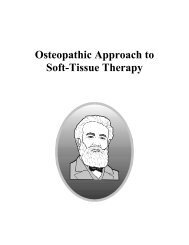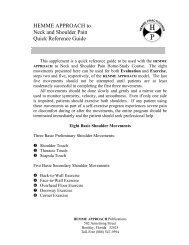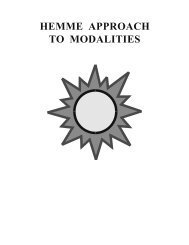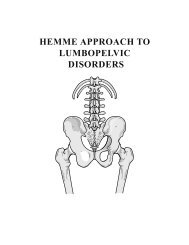HEMME APPROACH TO SOFT-TISSUE THERAPY
HEMME APPROACH TO SOFT-TISSUE THERAPY
HEMME APPROACH TO SOFT-TISSUE THERAPY
You also want an ePaper? Increase the reach of your titles
YUMPU automatically turns print PDFs into web optimized ePapers that Google loves.
The same principle applies to the soleus and gastrocnemius. Though<br />
both muscles plantar flex the foot, the soleus is a one-joint muscle and the<br />
gastrocnemius is a two-joint muscle. When the knee is flexed: (1) slack in<br />
the gastrocnemius reduces plantar flexion strength by about 70 percent, and<br />
(2) the soleus can be partially isolated and tested by testing plantar flexion.<br />
● Three points are important for the safety of the patient:<br />
1. Apply resistance slowly (easy on).<br />
2. Do not break the patient's contraction.<br />
3. Remove resistance slowly (easy off).<br />
Resistance should be applied slowly to give the patient enough time to<br />
apply a counterforce. Force applied too quickly may break the patient's<br />
contraction and cause tissue damage. As a rule, the examiner should stop<br />
counterforce when the patient's contraction changes from isometric to<br />
eccentric and the muscle starts to yield. On the opposite side, force removed<br />
too quickly may cause a rebound effect and cause tissue damage.<br />
Isometric resistance is normally applied when a muscle is at or slightly<br />
beyond normal resting length. Because of the arrangement of myofilaments<br />
in the sarcomeres and the viscoelastic properties of a muscle, most muscles<br />
are strongest when the muscle is at or near resting length and weakest when<br />
the muscle is fully stretched or fully shortened. Resting length is normally<br />
about midway between fully contracted and fully stretched. The biceps<br />
brachii approaches resting length when the elbow is flexed to about ninety<br />
degrees.<br />
As a caution, testing a muscle when distal and proximal insertions are<br />
not far enough apart to keep tension on a muscle during contraction may<br />
cause cramping. Any condition that allows actin and myosin myofilaments<br />
to overlap seems to encourage painful spasm. This can be demonstrated by<br />
placing the elbow joint in full flexion (sagittal plane) and then slowly and<br />
carefully contracting the biceps brachii. With only mild contraction, the<br />
biceps will normally start to cramp.<br />
Although high degrees of precision are sometimes required, most<br />
muscles can be tested as a group. According to Beevor's axiom, the body<br />
36<br />
<strong>HEMME</strong> Approach to Soft-Tissue Therapy









